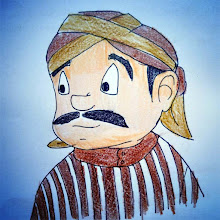THE EXHAUSTION from the twelve-hour journey from Lamongan to Cirebon seemed to fade the moment I stepped into the cool and leafy Larangan neighborhood. For a moment, I thought I had arrived in a village—as it felt so serene—but it turned out to be an urban housing complex. The warm December sun peeked through the shade of tall trees, and the sight of Mr Agus greeting me with a cheerful smile instantly made the day feel lighter.
He
sat comfortably in a chair just opposite me at the baperkam (community meeting hall) that fine morning. When he spoke, his confident gaze
drifted, as if deciphering a hidden message from an old passage. His deep voice
resonated with self-assurance.
“According to the wise, three things can transcend space and time: human values, education, and the environment.”
In other words, he believes that environmental awareness can help reduce religious radicalism. That remark came from Agus Supriono, who heads a neighborhood in Larangan Cirebon and also runs the Merbabu Asih Proklim (Climate Village Program).
 |
| Environmental care leads to food security. (personal doc) |
On a visit back in 2018, I had the privilege to walk around the kampong dubbed the Kampung Berseri Astra (KBA) that he oversees, allowing me to finally prove what he claimed. With all the greenery and ample vegetation around, to be honest, I would've mistaken it for a traditional village rather than a housing complex if he hadn't clarified.
From faith diversity to eco-harmony
From the main gate, on the right side of the road or across from Taman Astra, I saw a path leading to the Bodhi Sejati Temple. We made our way there and then chatted briefly in front of the temple surrounded by shady trees.
Leaving the temple, I turned right and spotted Pura Agung Jati Pramana--a Hindu temple on Bali Street, directly across from a nursing home run by the local Christian foundation. Quite surprisingly, the temple wall stands right next to that of the As-Salam Mosque, symbolizing a beautiful interfaith harmony.
 |
| Harmony in diversity, a foundation for sustainable environmental preservation | Personal document |
I learned another striking detail from my chat with an older gentleman, Pak Haji. His home, which sits next to the nursing home, has a large yard that's regularly used for bus parking when local Hindus have events at the temple. It's a wonderful illustration of the religious harmony thriving in Merbabu Asih, Cirebon, West Java.
Adherents of other religions, especially
Muslims, will volunteer to act as parking attendants and provide security
during the event.
"This is what we call smart NKRI, also smart environment!" said Mr. Agus, asserting the value of interfaith harmony.
He confidently explained that the strong sense of togetherness among residents stems from their shared awareness of caring for the environment they inhabit. In essence, the community’s spirit of tolerance becomes the foundation for addressing collective issues — from waste management to flood prevention.
It’s a common sight to see neighbors of different faiths gathering at the baperkam to cook and share meals. They enjoy the harvest from their KRPL (Kawasan Rumah Pangan Lestari — Sustainable Food Area); vegetables and fish are freshly picked, rice is donated by residents, while crackers and side dishes come from others.
Sitting cross-legged on the floor, they share the food on banana leaves — a familiar village tradition. Conversations flow naturally, with no barriers of ethnicity or religion. Harmony thrives across generations, uniting both children and adults in a spirit of mutual respect and joy.
Patience leads to awareness
It was Chaidir who first sparked the birth of Proklim Merbabu Asih. Seventeen years ago, he grew worried about the foul smell from a garbage dump near his home. Together with Agus, he decided to take action against the climate-related disasters that frequently struck Cirebon. He vividly recalled the floods, landslides, droughts, and disease outbreaks caused by poor sanitation in those days. Thanks to Proklim’s initiatives, their neighborhood now enjoys a flood-free environment.
“Whenever it rains heavily, the water just says kulanuwun,” Agus joked with a laugh — meaning that the rainwater politely passes through without leaving any puddles behind.
Agus and Chaidir admitted the journey to becoming a prominent Kampung Berseri Astra (Astra's Bright Village) was far from easy. It required endless patience and unwavering commitment to build a community that truly cares for the environment.
 |
| Agus leads with wisdom and confidence. |
When asked how they inspired residents to adopt a Proklim mindset, Agus mentioned three principles he consistently reminded everyone of. With a firm tone, he stated,
“I couldn't help asking them to think: first, we live within a living environment. Second, the amount of waste grows faster than the population. Third, only a fool would reject a clean village.”
These powerful reminders were delivered during community gatherings, Friday sermons, religious events, and other important occasions.
Gradually, this awareness took root, evolving into a shared energy that sustains their collective spirit of environmental care — an enthusiasm that continues to thrive today.
The energy of shared kindness
At first glance, the word giat (meaning active) may sound ordinary, yet it holds deep meaning. It represents a continuous reminder for residents to stay active — nurturing habits that keep the spirit of togetherness and environmental stewardship alive. It sends a stronger message than the word program for a villager to connect to.
As we left the baperkam, Agus told me that it's imperative to keep away from hotmix-minded when it comes to rural roads. They had therefore chosen paving blocks over asphalt for their village roads so that rainwater could seep naturally into the soil and replenish the groundwater.
“People take so much from the earth,” Agus said thoughtfully, “but they rarely think about giving it back.”
That’s where the infiltration wells play their role. Seventeen of them were built across the neighborhood to collect and store rainwater, ensuring residents could access it during dry seasons.
 |
| The biopore point and infiltration well prevent flooding and store water for later use. (Personal doc) |
“Honestly speaking we don’t even have our own wells here,” Chaidir added with a grin. “It’s our neighbors who are likely to enjoy our preserved water.”
I nodded when Agus concluded, “In the end, it all turns into goodness!” Because the energy of shared kindness truly thrives through collaboration across faiths in caring for the environment.
This is what genuine environmental harmony looks like: the willingness to act and to share. Floods and puddles are now a thing of the past, thanks to the infiltration wells and 118 biopore points that double as composting spots. Some wells have even been converted into catfish ponds to add more value.
To create more good, rainwater must never go to waste. It’s channeled through special pipes into designated wells—near the mosque, the baperkam, and several other points.
 |
| Rainwater harvesting, a productive move for everyone (personal doc) |
Beyond water conservation, these reservoirs also help maintain the structural strength of nearby buildings, preventing cracks and erosion.
“The key,” Agus explained when asked how residents first responded to the idea, “is to turn complex concepts into simple language they can relate to.”
Sustainable environmental management
Thanks to their integrated and sustainable approach to environmental management, it’s no surprise that a refreshing coolness enveloped me as I strolled through the village lanes. Every corner bursts with life—lush greenery shading the narrow alleys and giving the air a soothing calm.
Because of this, Merbabu Asih Neighborhood has earned numerous awards for its outstanding environmental efforts, becoming a model for the government’s Climate Village Program (ProKlim). Here, sustainability isn’t just a slogan—it’s a daily practice.
 |
| Fine crafts made of plastic waste (Personal doc) |
Everything is transformed into something useful, even waste. Organic trash is turned into compost, while non-organic materials are crafted into products of economic value. Plastic waste, for instance, isn’t discarded but creatively woven into stylish bags worth hundreds of thousands of rupiah. Still, most non-organic waste is collected and sold by mutual agreement.
IDR 150+ millions from waste
To manage the proceeds, residents founded a waste bank named Bank Sampah Secerah Pagi (BSSP)—an acronym for Semoga Cepat Rapih Pekarangan Asri Gemerlap Indah.
“Well, it’s more than a name—it’s a prayer!” said Dedeh, the cheerful woman overseeing BSSP when I met her that afternoon.
And indeed, “Secerah Pagi” captures the community’s spirit perfectly. Like the morning sun, their energy shines bright—optimistic, warm, and full of life.
Every Saturday morning, BSSP officers would go door-to-door to collect waste instead of waiting for residents to drop it off. The trash is sorted, weighed, and recorded in personal account books. Interestingly, when Agus introduced the infak system—an instruction to sell waste slightly below market price—everyone agreed. Infak is short for instruksi faksa that literally means a forced instruction.
The sales proceeds are distributed after the waste is sold, yet many residents voluntarily donate their earnings to grow BSSP’s fund.
“That’s what I call shared blessings!” Agus said in his deep, proud tone.
For transparency and accountability, residents later established the Secerah Pagi Cooperative. Out of 111 customers, 69 have joined, collectively growing the capital to IDR 152 million—all starting from almost nothing.
 |
| The shared ownership allows them to run a life of independence and resilience. (personal doc) |
Each member can access small, interest-free loans from IDR 4 to 10 million, with simple terms and flexible repayments. Fund management is handled in a family-like manner, ensuring that every contribution—financial or moral—flows back to strengthen their shared vision of a thriving, sustainable community.
It's obvious the cooperative has not only enabled them to manage their own sustainable food area, but also paved the way toward a life of independence and resilience. Through collective effort and shared ownership, residents have learned to rely on one another, transforming simple waste management into a self-sustaining ecosystem.
Astra’s steadfast support
The success of the waste bank in Merbabu Asih cannot be separated from the consistent support of PT Asuransi Astra Buana (AAB) , Cirebon branch. As part of their Corporate Social Responsibility (CSR) program, Astra has been donating non-organic office waste to Bank Sampah Secerah Pagi (BSSP). The waste is then processed and sold by BSSP, with the sales reports transparently shared back with AAB.
This partnership is more than symbolic—it’s sustainable. The continuous flow of support has fueled the growth of the waste bank, allowing the profits to return to the community in the form of welfare and environmental empowerment programs.
Astra’s involvement doesn’t stop there. The company also donated 1,500 tree seedlings to strengthen the village’s greening movement and increase oxygen availability. Residents welcomed this assistance warmly, feeling an emotional and spiritual connection with Astra’s commitment to environmental growth. Over time, Astra also supported the acceleration of ProKlim (Climate Village Program) by helping to build a park that serves both ecological and aesthetic functions.
 |
| The oxygen zones that provide free fruit and fresh air (personal doc) |
Agus and his team further enhanced this effort by establishing five oxygen zones — green shelters filled with climbing plants that provide shade, clean air, and even edible produce. These plants are not just decorative; they’re functional. Grapes, passion fruit, Japanese cucumbers, and grass jelly vines climb gracefully over poles, offering both nutrition and beauty to anyone who passes by.
“When people at the hospitals spend a lot of money for oxygen, we simply get it from our plants for free,” Agus explained, smiling. His simple message carries profound truth: through planting, people breathe life into their community.
At the main entrance, Astra Park stands as a proud symbol of Astra’s social and environmental vision. The park’s mega mendung batik motif on the walls serves as a cultural touchpoint, reminding everyone to honor local identity. Next to it, the inscription Peace of Mind radiates a message of unity and calm—an embodiment of the interfaith harmony that defines KBA Larangan.
Food security in practice
When Agus mentioned that residents’ monthly contributions remained stable while other neighborhoods faced rising expenses, I couldn’t help but smile in disbelief.
“That’s because they’re secure: secure in the cooperative, in the waste bank, and in education,” Agus said confidently. In short, economic independence has become their foundation.
Visitors who come in groups often contribute financially by filling a charity box, which supports shared meals and environmental management training on the premises. Guests are then treated to Cirebon’s traditional dishes—a delicious way to promote local culinary culture.
Food security here is more than a slogan. It’s a reality. Despite limited land, the residents have managed to transform a once-empty plot into a thriving Sustainable Food Area. The land, owned by one resident, is now a communal farming zone with a small greenhouse for seedlings and nurseries.
On just 60 square meters, they grow a wide variety of vegetables and fruits: spinach, kale, bok choy, limes, corn, eggplants, chilies, papayas, guavas, and even tubers—all harvested in turns. Residents can freely take what they need, no purchase necessary.
 |
| The sustainable food area, a corner of happiness (Personal doc) |
So, while others often complain about rising chili prices, Merbabu Asih residents simply pick fresh chilies from their backyard gardens.
Nothing goes to waste. In one corner of the KRPL, a tarpaulin fish pond measuring about one by six meters is filled with tilapia donated by the local agricultural office. The fish can be harvested whenever needed—often for communal meals at the baperkam.
The spirit of food security extends far beyond this shared land. Across the 5.8-hectare neighborhood, greenery fills every alley and yard. From hydroponic setups to plants in polybags, residents maximize every inch of space in front of their homes.
In front of Chaidir’s house, for instance, I saw water spinach, chilies, onions, kenikir, starfruit, papaya, and moringa flourishing. Mango and guava trees donated by Astra provide shade along the street.
Indeed, food security has become a shared value here. It is a form of collective consciousness about humanity’s dependence on nature. Residents no longer see the environment as separate from their lives but as a partner in sustaining them.
The secret of impactful act
The unity among diverse religious communities in Agus's neighborhood has created powerful synergy in achieving environmental sustainability and food resilience. It’s no surprise that in 2017, Merbabu Asih was named First Place in Astra's Bright Village (Kampung Berseri Astra) —surpassing five other national finalists.
 |
| Victory strengthens their efforts, not emboldens mere pride. (Personal doc) |
The award opened doors for other communities eager to learn the secrets of tolerance-driven environmental success. Visitors from other cities, government agencies, universities, and local communities have come to study at this humble neighborhood. Even representatives from Indramayu and Kuningan once learned here, later earning the Adipura environmental award for their own towns—a source of pride for Agus and his team even when Cirebon didn't.
Recognition has also come from abroad. Guests from Malaysia, Australia, Myanmar, the United States, Canada, the United Kingdom, and Sweden have all visited KBA Larangan. They expressed admiration for how a simple, community-based approach could produce such meaningful change.
As one of Astra’s Bright Villages, Merbabu Asih stands as living proof that when people of different faiths come together to care for the environment, harmony is no longer just an ideal—it becomes a daily reality. Here, unity grows from shared values and a collective purpose: to nurture both the earth and the spirit of the community.
 |
| KBA Merbabu Asih's winning is due to love and compassion. (Personal doc) |
The success of KBA Merbabu Asih is not a story of brilliance or luck, but of courage and perseverance to take the first steps—steps that not everyone is willing to take, as they offer no instant economic rewards. The skill of Agus and Chaidir in uniting the local community—despite differences in faith—has become a vital foundation that ultimately creates lasting, positive impact. And environmental stewardship is the spark that keeps their harmony alive!


























